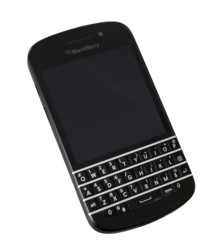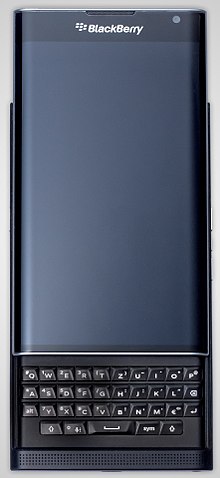BlackBerry
![]()
This article describes the mobile phone. For other meanings see Blackberry (disambiguation).
![]()
![]() (pronunciation [ˈblækbəri], English for blackberry) is the brand name for smartphones from the Canadian company Blackberry Limited (previously Research in Motion, or RIM for short). Characteristic is the physical keyboard, which is still used in almost all models. In the past, Blackberry developed the device hardware and the operating system BlackBerry OS itself and distributed it including the BlackBerry Enterprise Server as a comprehensive and secure communication solution. The "Hub" at the center bundles messages such as calls, SMS, emails, tweets, etc. Since 2016, the devices are developed and manufactured under license, they are based on Android, which is hardened by the company BlackBerry.
(pronunciation [ˈblækbəri], English for blackberry) is the brand name for smartphones from the Canadian company Blackberry Limited (previously Research in Motion, or RIM for short). Characteristic is the physical keyboard, which is still used in almost all models. In the past, Blackberry developed the device hardware and the operating system BlackBerry OS itself and distributed it including the BlackBerry Enterprise Server as a comprehensive and secure communication solution. The "Hub" at the center bundles messages such as calls, SMS, emails, tweets, etc. Since 2016, the devices are developed and manufactured under license, they are based on Android, which is hardened by the company BlackBerry.

Then US President Barack Obama on Air Force One with his BlackBerry in a holster

Blackberry Z10

Blackberry Q10

Blackberry Priv
History
In 1999, RIM launched the first device called Blackberry 850, which subsequently ushered in the age of mobile communication. For the first time it was possible to retrieve e-mails via a mobile internet connection or to synchronize new appointments wirelessly. The first Blackberry smartphone that was not yet fully developed was the successor model Blackberry 5810 with an integrated mobile phone, which was introduced in 2002.
Blackberry developed various smartphones based on the Blackberry OS, including the popular Bold and Curve series. The company focused on business customers, but expanded the functionality in the course of time in order to win over the private user segment.
In October 2011, Blackberry introduced the new Blackberry 10 operating system at its in-house developer conference, which was used by then-current models like the Blackberry Q10, Classic, Z10 or Passport. Previous OS versions are referred to as legacyOS, according to the report. At the end of 2014, the Amazon Appstore was made available for all Blackberry 10 devices, through which the Android apps available on Amazon can be installed. Since the devices were designed as so-called workhorses for the office, they had a low processor power and no 3D graphics processor, which allowed about twice as long battery runtimes as other manufacturers - but did not allow elaborate 3D games.
The company missed the move away from keyboards to touchscreens in 2008. As a result, mobile phone sales plummeted in early 2011 and BlackBerry experienced dramatic revenue declines in the years that followed. In 2013, John Chen took over as CEO and refocused the business on software and services. As part of that, Blackberry divested itself of its own smartphone development and manufacturing in 2016, licensing devices only to cut costs. As a result, BlackBerry is a software-only provider in the smartphone space. Chen explained in an interview in 2016 that there will still be Blackberry-branded smartphones with keyboards in the future.
A year later, Blackberry released the PRIV model, its first own smartphone with an Android system. BlackBerry hardens software and hardware to offer some of the most secure Android smartphones on the market.
In February 2020, they announced they would cease production.
Many analysts had assumed an end to the brand and the physical keyboard, but they have announced another smartphone for 2021, it is said to be 5G-enabled and manufactured by Onward Mobility.

Blackberry 7290 from the year 2004
Function
The essential function of a legacy Blackberry smartphone is to be able to receive and send mobile emails as a push service. In addition, Blackberrys offer the usual smartphone functions, such as address book, calendar, instant messenger (WhatsApp or the discontinued Blackberry Messenger), to-do lists, to-do lists, etc., plus mobile phone functions such as telephony, SMS, MMS and web browsing. Unlike a traditional PDA, the Blackberry user does not have to worry about synchronizing the data.
BlackBerry devices up to BlackBerry OS 7.1 had to be connected via the BIS option to establish a data connection. For business customers, the BES (BlackBerry Enterprise Server, from version 12 BlackBerry Enterprise Services) is available, which is set up on-premises or in the cloud and establishes communication via the BlackBerry Network Operation Center (NOC). BlackBerry rebranded with version 12.6. The vendor now offers to manage all mobile endpoints through its in-house server software and NOC. Since then, the name Unified Endpoint Manager (UEM) has been used for the EMM system.
With Blackberry devices, emails, calendar entries, notes and address book entries are transferred from the Blackberry NOC to the smartphone via push service. The device is therefore always kept up to date as long as there is a data connection. At the same time, it enables immediate notification and delivery of new e-mails and appointments in real time. Another important function results from the Mobile Data System (MDS), which makes it possible to make other data from the company network - from ERP systems, databases, etc. - accessible on the Blackberry. For example, price or stock information can be called up, order processes triggered or customer data changed.
Blackberry technology deliberately keeps the amount of data to be transmitted small: the Blackberry Enterprise Server (BES) processes all data specially, compresses it and then outputs it to the end device in portions. Only when the user needs more data is it requested by the device. The request is made without the user noticing or having to wait. In this way, MByte-sized files (such as PDF or Office files) can be opened quickly despite a GPRS or EDGE connection (for example, on the train): The BES opens the attachment on demand, converts it into a text-oriented file and sends it to the client in a bundle. Via POP3 protocol, the server would send the whole file unchanged to the client: That is, the user cannot open the file until it is fully downloaded; the user would need a powerful terminal device to be able to process larger files appropriately. In addition, all traffic from the server out of the corporate network to the smartphone and back is encrypted. The original Blackberry devices can also be set to not only secure the device content via password, but also to encrypt it.
The Blackberry service can only be used on older devices (before the introduction of OS 10) with a special BIS option, which must be booked separately for the mobile phone card with the mobile phone operator. This so-called "Blackberry option" includes a basic fee and a fee for the commissioned data volume. For the Blackberry Push service, with about 500 e-mails per month and calendar use of about 100 entries per week, hardly more than 1 MB per month is consumed.
Since Blackberry OS 7.0, the DocumentsToGo software from DataViz has been part of the operating system; documents and file attachments can thus also be viewed natively. The editing function of Office documents is also possible. The software enables the creation of Microsoft Word, Excel or PowerPoint files, for example.
Search within the encyclopedia